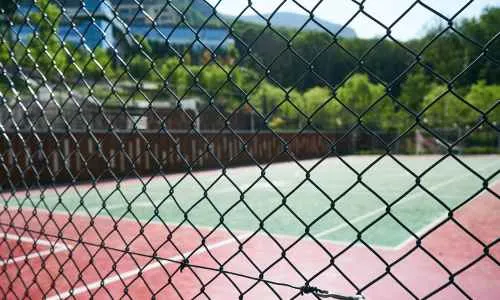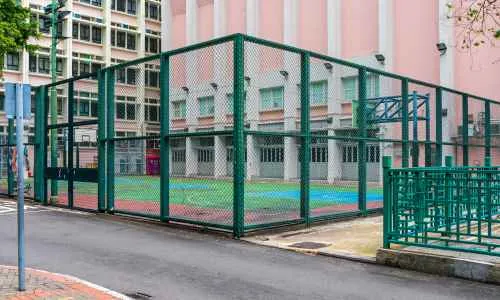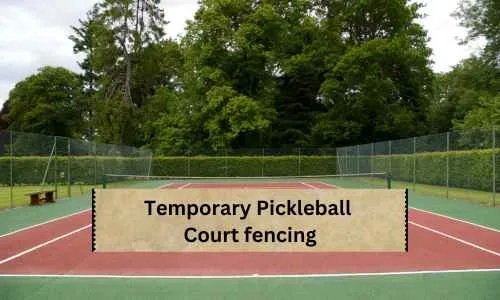Discover the costs of installing fencing around a pickleball court. Get insights into factors affecting pricing and tips for optimizing your budget. Ensure safety, ball containment, and aesthetics while making an informed investment for your pickleball court project.
Table of Contents
cost of installing fencing around a pickleball court
The cost of installing fencing around a pickleball court can vary significantly depending on various factors, including the type of fencing material, the size of the court, the level of customization desired, labor costs in the local area, and any additional features or accessories required. Fencing is an essential component of a pickleball court, serving purposes such as safety, ball containment, and aesthetics. However, understanding the cost considerations can help individuals, communities, and organizations make informed decisions when planning and budgeting for this valuable addition to the court.
Cost of Fencing Around a Pickleball Court:
- Basic Chain Link Fence: For a standard chain-link fence, you can anticipate a cost ranging from $2,000 to $6,000, depending on various factors outlined earlier.
- Upgrading for Durability and Aesthetics: If you opt for more durable or visually appealing fencing options, such as vinyl-coated or wood privacy fences, budget upwards of $10,000.
- The Small-Town Kid Who Became a Pickleball Superstar! Dylan Frazier’s Inspiring Story
- Amazon Prime Day Pickleball Deals 2024: Take up to 50% Off on Paddles
- Pickleball’s ‘low-impact’ reputation doesn’t mean low-injury. How to stay safe playing the fast-growing sport.
- Club tennis ‘endangered’ as other racket sports grow, Novak Djokovic warns
- Pickleball points: Here are some tips and strategies specifically for seniors
Why might you want to install fencing around a pickleball court?
Installing fencing around a pickleball court serves several important purposes:
- Safety: Fencing provides a barrier that helps keep players and spectators safe. It prevents errant balls from leaving the court and potentially causing injury to people or damage to nearby property.
- Ball Containment: Pickleball courts are relatively small and involve fast-paced ball movement. Fencing helps contain the balls within the court, reducing the time spent retrieving them and ensuring a smoother, uninterrupted game.
- Privacy: Fencing can provide privacy for players by keeping onlookers and passersby from closely observing the game. This can enhance the overall playing experience and concentration.
- Noise Control: Fencing can help dampen the noise generated during gameplay, making it less disruptive to neighbors or nearby residents.
- Wind Resistance: In areas with strong winds, fencing can act as a windbreak, making it easier for players to control the ball and maintain the integrity of the game.
- Aesthetics: Fencing can contribute to the overall aesthetics of the pickleball court and its surroundings, helping define the court’s boundaries and adding to the overall appeal of the facility.
- Security: Installing fencing can deter unauthorized access to the court, protecting it from vandalism or misuse when not in use.
In summary, installing fencing around a pickleball court serves various practical and safety-related purposes, contributing to a better overall playing experience for participants and ensuring the court’s functionality and security.

Consider Before Fencing a Pickleball Court
Fencing a pickleball court is a crucial step in ensuring safety, defining boundaries, and maintaining the integrity of the game. However, before you proceed with fencing, you must consider several essential factors to ensure that your pickleball court fulfills the necessary standards and serves its intended purpose. Here are some key aspects to keep in mind.
Fence Material:
Choose a durable and weather-resistant material for the fencing. Chain-link fencing is a popular alternative Because of its low cost and durability. Vinyl and wood are also options for a more aesthetically pleasing look.
Fence Height:
As mentioned earlier, the standard fence height for pickleball courts is typically 10 feet (3.05 meters). Ensure that the fence is of uniform height around the entire court.
The Cost Of Resurfacing A Pickleball Court: What You Should Expect
End Fencing:
The end fencing should extend to the full height of the side fencing to create a complete enclosure. This prevents balls from going out of bounds and provides a clean look to the court.
Gate Placement:
Consider their placement carefully if you include gates for player and equipment access. Typically, gates are positioned at the ends or sides of the court to allow easy entry and exit. Ensure they are wide enough for players and equipment to pass through comfortably.
Gate Design:
Gates should be secure and designed to withstand frequent use. Consider adding a latch or lock mechanism to prevent unauthorized access when the court is not in use.
Wind Screens:
Some courts use windscreens on the fencing to reduce wind interference during play and improve visibility. If you install windscreens, ensure they are securely attached and provide good visibility for players.
Color and Aesthetics:
While functionality is crucial, aesthetics also matter. Choose a fence color and design that complements the overall look of your facility or court area.
Padding:
Depending on your budget and safety considerations, add padding to the fencing posts and top rail to reduce the risk of player injury in case of accidental collisions.
Safety Considerations:
Ensure that the fencing is constructed with the safety of the players in mind. Eliminate any prominent or rough components that could cause injury to participants.
Local Regulations:
Always check local building codes and regulations regarding fence design, height, and materials. Compliance with these regulations is essential to avoid potential legal issues.
Working with professionals experienced in court construction or fencing installation is a good idea when designing pickleball court fencing. They can help you choose suitable materials, designs, and specifications to create a safe and functional court that meets your needs and local requirements.
What are the different types of fencing material available?
Chain Link Charm: Opting for chain link fencing is popular and cost-effective for pickleball courts. The price per linear foot can span from a budget-friendly $5 to a more premium $15, depending on factors like the quality and desired fence height.
Vinyl Elegance: If you aim for aesthetics and durability, vinyl fencing might be your preference. It provides a polished appearance but often comes at a higher cost, ranging between $20 to $40 per linear foot.
Wooden Wonder: Wood fencing can be considered for a touch of natural elegance. However, it typically falls on the higher end of the price spectrum, with costs fluctuating between $20 and $50 per linear foot. Wood type and design intricacies can significantly influence the final price.
Aluminum Fencing: Aluminum fencing tends to be in the mid-price range, averaging between $20 and $40 per linear foot for materials and installation. The cost can vary based on the design and height of the fence.

Factors that affect the cost of fencing
Court Size:
The dimension of a pickleball doubles court is the same as that of a pickleball singles court, which is 20 feet wide by 44 feet long. This is the same size as a doubles badminton court.
The pickleball court is divided into four quadrants by a 7-foot non-volley zone, also known as the “kitchen,” in front of the net on each side. The kitchen is an area where players cannot volley the ball.
Height of Fencing:
The standard fence height for pickleball courts is typically 10 feet. Taller fences may be required if you have specific regulations or preferences.
Gate(s):
Remember to factor in the cost of gates for player and equipment access. Gate prices vary based on size and material.
Labor Costs:
Installation costs can also vary depending on the complexity of the project, the terrain, and local labor rates.
Location and Permitting:
Local building codes and permitting requirements can affect the overall cost. Check with your local authorities for any necessary permits and regulations.
Additional Features:
If you want additional features like windscreens, lighting, or privacy slats, these will add to the overall cost.
Contact fencing contractors or suppliers in your area is best to get an accurate estimate. They can provide you with quotes based on your specific needs and preferences. Additionally, consider obtaining multiple quotes to compare prices and choose the best option for your budget.
pickleball court fencing dimension
The dimensions for pickleball court fencing can vary depending on the specific court layout and any local regulations or preferences, but here are some general guidelines for typical pickleball court fencing dimensions:
Court Length:
A standard pickleball court length is 44 feet (13.41 meters) for both singles and doubles. Therefore, the fencing should extend the entire length of the court.
Court Width:
For a standard pickleball court, the width is 20 feet (6.10 meters) for both singles and doubles. Fencing should enclose the entire width of the court.
Fence Height:
The recommended fence height for a pickleball court is typically 10 feet (3.05 meters). This height helps to contain the ball during play and prevents it from going out of bounds.
Net Clearance:
Ensure that the fencing allows for adequate net clearance. The net height at the center of the court should be 34 inches (0.86 meters) for singles play and 36 inches (0.91 meters) for doubles play. The fencing should not obstruct this clearance.
Gates:
If your pickleball court includes gates for player and equipment access, ensure they are wide enough to accommodate players and equipment comfortably. Standard gate widths are often around 3 to 4 feet (0.91 to 1.22 meters) or more.
Temporary pickleball fencing
A temporary pickleball fence is a versatile solution for creating boundaries around a pickleball court for temporary or portable use. It’s often used for events, tournaments, or situations where a permanent fence isn’t feasible. Here are some options for setting up a temporary pickleball fence:
Portable Fencing Panels:
Portable fencing panels made from materials like PVC, plastic, or metal are readily available temporarily. These panels are easy to assemble and disassemble, making them ideal for events and temporary courts. They can be connected to create the desired court boundaries and are usually lightweight for easy transportation.
Mesh or Fabric Screens:
Mesh or fabric screens can be hung on temporary supports, such as posts or temporary fencing stakes, to create court boundaries. These screens are often used for wind control and to provide some visual separation. They are lightweight and easy to store and travel.
Temporary Net Systems:
Portable pickleball net systems are available that include netting and support structures. These can be set up and taken down quickly and are designed specifically for pickleball court boundaries.

Temporary Fencing Stakes:
Use temporary fencing stakes or posts with ropes or mesh fencing to create a temporary court boundary. This method is cost-effective and easy to set up but may provide a different level of ball containment than more rigid options.
Painted Lines on Temporary Surface:
If you’re playing on a temporary or non-standard surface like a parking lot or gymnasium floor, you can use temporary court boundary lines made of tape or chalk to define the court’s boundaries.
Inflatable Court:
Some inflatable court systems have built-in fencing to create a temporary pickleball court. These are convenient for events and can be inflated and deflated quickly.
Barricade Fencing:
Temporary barricade fencing, similar to what is used for crowd control at events, can be used to create court boundaries. It’s sturdy and provides suitable containment but may require more effort to set up.
When choosing a temporary pickleball fence option, consider factors such as ease of setup, durability, cost, and your needs for containment and aesthetics. Ensure the temporary fence complies with any event or facility regulations and safety requirements.
Tips for Saving Money on Fencing Installation:
- Compare Estimates: Obtain detailed estimates from at least three contractors to ensure you get the best price for your fencing project.
- Consider Cost-Effective Materials: Explore affordable fencing materials like chain link and vinyl, which can save you money compared to wood or wrought iron.
- DIY Installation: If you have the skills and tools, consider installing the fence yourself. Ensure you’re well-prepared before attempting this option.
- Cost Sharing with Neighbors: Share the expenses with neighbors if they’re also interested in fencing, particularly for long fence lines.
- Negotiate Pricing: Don’t hesitate to negotiate with contractors once you’ve collected estimates. Many are open to negotiation, especially if you can pay in cash or contribute to the work.
- Look for Discounts: Inquire about discounts for specific groups, such as seniors or military members, as many fencing contractors offer such incentives.
Additional Money-Saving Tips:
- Plan Ahead: Give yourself ample time to plan your fencing project, increasing your chances of finding cost-effective materials and labor.
- Flexibility with Schedule: Consider scheduling the installation during the off-season to maximize potential contractor discounts.
- Participate in the Work: Even if you’re not highly skilled, there are tasks like digging fence post holes or assisting with panel installation that you can do yourself to reduce costs.
Conclusion
In conclusion, fencing around a pickleball court is a crucial investment that enhances safety, ball containment, and the overall playing experience. While costs can vary depending on factors like material choice, court size, and customization, balancing your budget and the desired features is essential. You can make a well-informed decision by considering the tips for cost savings and the specific needs of your pickleball court project. Ultimately, a well-fenced pickleball court provides functional benefits and contributes to this exciting sport’s enjoyment and longevity.

